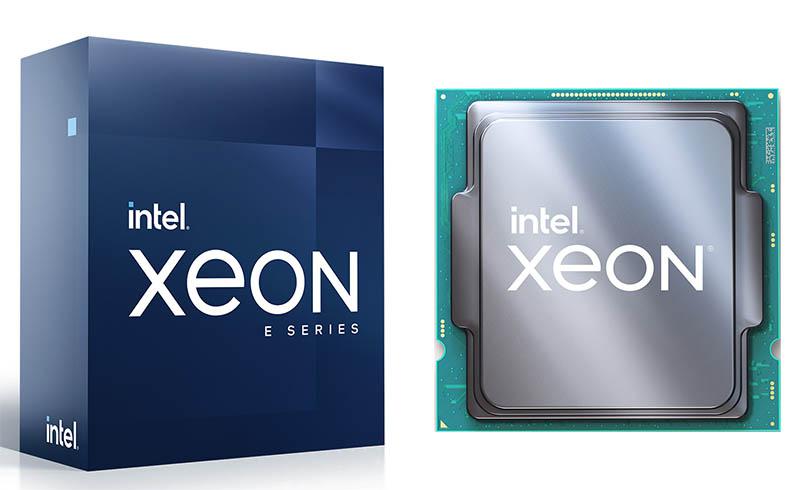Intel announced the launch of ten Rocket Lake-based CPUs for the server market, marking the first update to its Xeon 2000 series since the release of the previous-gen Coffee Lake-E Xeon E-2200 family in Q2 2019. The CPUs are part of the Intel Xeon E-2300 series, which make up the company's entry-level, server-bound offerings that aim for stability more than actual benchmark dominance (Intel has validated compatibility with Windows Server 2022 already). The lineup spans from a $182 quad-core Xeon E-2314 up to a $539 eight-core E-2388G, all powered by Intel's latest Cypress Cove architecture etched onto the 14nm process.
Being entry-level offerings, these chips are aimed more at small businesses looking to improve or scale their digital infrastructure than they are geared for data centers. For those, Intel has far more powerful and far more costly Ice Lake Xeon Scalable solutions.
The Xeon E-2300 processor family is available in configurations of 4, 6, or 8 cores (8, 12, or 16 active threads due to the implementation of Intel's Hyper-Threading technology). Intel uses HyperThreading to segment this generation of chips, as the two lowliest entries (the E-2324G and E-2314) do away with threading, offering only four cores. Another giveaway to the entry-level design of the Xeon E-2300 series is that it's been locked out of dual-socket offerings - only 1S (single-socket) motherboards will be available from Intel partners (such as ASUS, Supermicro, Gigabyte, and others) for this family, all making use of the new H5 socket (LGA 1200, Tatlow platform).

As usual in this price category, Intel banks on the more streamlined and predictable stability pipeline for these server-bound designs, like the added safety net of full Intel SGX (Software Guard eXtensions) support, and certain businesses' difficulties with migrating their operations to a cloud-based solution (mostly due to small use of legacy, or at least not cloud-capable, applications).
Intel's product stack covers quite a bit of ground throughout its ten processors: businesses can scale from a $182 quad-core Xeon E-2314 up to a $539 eight-core E-2388G.
Image 1 of 3Image 2 of 3Image 3 of 3The Xeon E-2300 uses Cypress Cove cores, which rework the Sunny Cove cores Intel deployed on its Ice lake mobile architecture to the more cost-effective 14nm node. Other platform improvements include support for up to 128 GB of ECC DDR4 memory in a dual-channel configuration, with maximum supported DDR4-3200 speeds - an increase from the Xeon E-2200 series' DDR4-2666 support. The Gen 12 Xe-LP graphics are also now enabled on some members of the Xeon E-2300 family. However, there's only support for direct display - still a marked improvement from the previous generation that didn't even offer that display capability.
Intel claims an up to 17% performance increase against the prior generation (Coffee Lake-E), though interestingly, Intel doesn't indicate if that's clock for clock. To generate that statistic, Intel tested one of the new Xeon entries, the Xeon E-2378G processor (eight-core, 16-thread, and the second-best model available in Intel's E-2300 family) against the Xeon E-2278G (eight-core, second-best model available in Intel's E-2200 lineup).
Image 1 of 2Image 2 of 2Perhaps more important than the additional per-core performance, however, is the PCIe subsystem. PCIe support has been expanded and upgraded, with CPUs based on this generation offering up to a total of 44 PCIe lanes. Of these, 20 are available in PCIe 4.0 (CPU), while the remaining 24, which are sourced from the C250 series chipset, default to PCIe 3.0.
Other expansion capabilities include support for up to eight SATA 3.0 ports; up to ten USB 3.2 Gen 2x1 ports at 10G speeds; and up to three USB 3.2 Gen 2x2 ports at 20G speeds. This evolution represents a marked difference from the previous-gen Xeon E-2200 CPUs, which only offered 16 PCIe 3.0 lanes out of the CPU, marking an extreme disadvantage from Intel in regards to AMD's Epyc competition, which this change aims to partially correct.
The highest-rated base frequency available in this family stands at 3.7 GHz (for the 4-core, 8-thread Xeon E-2374G), which can scale up to 5.1 GHz with the help of Intel's Turbo Boost 2.0 algorithms in certain parts (the top-of-the-line, eight-core Xeon E-2388G achieves this boost speed). The idea is that available performance is maximized irrespective of workload; Intel's Turbo Boost 2.0 determines the maximum clockspeed available for the current workload by taking multiple variables, including operating temperature and power consumption, into account.
Image 1 of 8Image 2 of 8Image 3 of 8Image 4 of 8Image 5 of 8Image 6 of 8Image 7 of 8Image 8 of 8As for power consumption, the 14 nm manufacturing process means that it can't be as reined in as much as it theoretically could should the more advanced 10nm were used instead; the TDP envelope of Intel's E-2300 family scales from 65W on the E-2314 entry-level model, sporting four cores without any HyperThreading, and up to 95W for the most powerful processor being announced today, the eight-core and 16-thread Xeon E-2388G.




